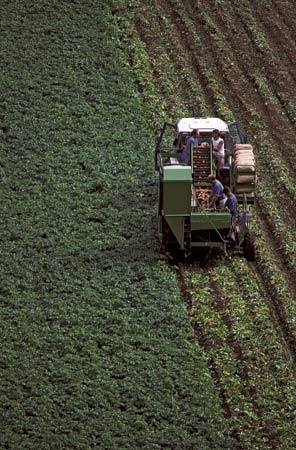potato
plant
(Solanum tuberosum), one of some 150 tuber-bearing species of the genus Solanum (family Solanaceae). The potato (common potato, white potato, or Irish potato), considered by most botanists a native of the Peruvian-Bolivian Andes, is one of the world's main food crops, differing from others in that the edible part of the plant is a tuber (i.e., the swollen end of an underground stem).
The potato plant is an herbaceous annual, 50–100 cm (20–40 inches) high. Leaf arrangement is spiral; leaves are compound and 20–30 cm long, consisting of a terminal leaflet and two to four pairs of leaflets, each 6–10 cm long.
Underground the stems extend into structures called stolons. The ends of the stolons may enlarge greatly to form a few to more than 20 tubers, of variable shape and size, usually ranging in weight up to 300 g (10 ounces) but occasionally to more than 1.5 kg (3.3 pounds). The skin varies in colour from brownish white to deep purple; the flesh normally ranges in colour from white to yellow, but it, too, may be purple. The tubers bear spirally arranged buds (eyes) in the axils of aborted leaves, of which scars remain. These buds may remain dormant after the tuber is fully grown, even under conditions favourable to development, for up to 10 weeks or more. They grow into plants identical to the plant that bore the tubers. Vegetative propagation of desired characteristics is thus possible, and this method is always used commercially because of the great variation that results when plants are grown from true seed.
 The potatoes cultivated in South America as early as 1,800 years ago probably consisted of a mixture of varieties; in the same area today, as many as 60 varieties may be distinguished in a single village market. Encountered by the invading Spaniards, potatoes were introduced into Europe during the second half of the 16th century. By the end of the 17th century the newcomer was a major crop in Ireland, and by the end of the 18th it was a major crop in continental Europe, particularly Germany, and in the west of England. The Irish economy itself became dependent upon the potato. It continued to spread, in both Western and Eastern hemispheres, during the first four decades of the 19th century, but the disastrous failures of the Irish (Irish Potato Famine) crops in the mid-19th century (especially in 1846 and 1848), because of late blight (Phytophthora infestans), and the ensuing famine led to a more cautious attitude toward dependence on it.
The potatoes cultivated in South America as early as 1,800 years ago probably consisted of a mixture of varieties; in the same area today, as many as 60 varieties may be distinguished in a single village market. Encountered by the invading Spaniards, potatoes were introduced into Europe during the second half of the 16th century. By the end of the 17th century the newcomer was a major crop in Ireland, and by the end of the 18th it was a major crop in continental Europe, particularly Germany, and in the west of England. The Irish economy itself became dependent upon the potato. It continued to spread, in both Western and Eastern hemispheres, during the first four decades of the 19th century, but the disastrous failures of the Irish (Irish Potato Famine) crops in the mid-19th century (especially in 1846 and 1848), because of late blight (Phytophthora infestans), and the ensuing famine led to a more cautious attitude toward dependence on it.Potatoes are frequently served whole or mashed as a cooked vegetable and are also ground into potato flour, used in baking and as a thickener for sauces. Potatoes are highly digestible. They also supply vitamin C, amino acids, protein, thiamin, and nicotinic acid.
- rock
- rockabilly
- Rockall
- rock and roll
- rockaway
- rock bolt
- Rock, Chris
- rock cress
- rock crystal
- rock edicts
- Rockefeller Center
- Rockefeller, David
- Rockefeller, John D.
- Rockefeller, John D., III
- Rockefeller, John D., Jr.
- Rockefeller, Laurance S.
- Rockefeller, Nelson Aldrich
- Rockefeller University
- Rockefeller, William
- Rockefeller, Winthrop
- Rocket
- rocket
- rocket and missile system
- Rockettes, the
- rock fan